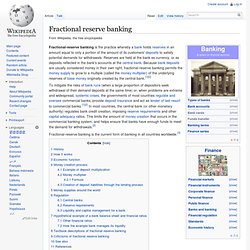

Fractional-reserve banking. Fractional-reserve banking is the practice whereby a bank holds reserves in an amount equal to only a portion of the amount of its customers' deposits to satisfy potential demands for withdrawals.

Reserves are held at the bank as currency, or as deposits reflected in the bank's accounts at the central bank. Because bank deposits are usually considered money in their own right, fractional-reserve banking permits the money supply to grow to a multiple (called the money multiplier) of the underlying reserves of base money originally created by the central bank.[1][2] Fractional-reserve banking is the current form of banking in all countries worldwide.[3] History[edit] Fractional-reserve banking predates the existence of governmental monetary authorities and originated many centuries ago in bankers' realization that generally not all depositors demand payment at the same time.[4] Reserve requirement. The reserve requirement (or cash reserve ratio) is a central bank regulation employed by most, but not all, of the world's central banks, that sets the minimum fraction of customer deposits and notes that each commercial bank must hold as reserves (rather than lend out).

These required reserves are normally in the form of cash stored physically in a bank vault (vault cash) or deposits made with a central bank. An institution that holds reserves in excess of the required amount is said to hold excess reserves. Effects on money supply[edit] The conventional view[edit] Asset liability management. Initially pioneered by Anglo-Saxon financial institutions during the 1970s as interest rates became increasingly volatile, asset and liability management (often abbreviated ALM) is the practice of managing risks that arise due to mismatches between the assets and liabilities.

The process is at the crossroads between risk management and strategic planning as is not just offering solution to mitigate or hedge the risks arising from the interaction of assets and liabilities but is conducting the bank from a long-term perspective (success in the process of maximising assets to meet complex liabilities may increase profitability) ALM objectives and scope[edit] The exact roles and perimeter around ALM can vary significantly from one bank to another depending on the business model adopted and can encompass a broad area of risks.
RBA Bank Funding.